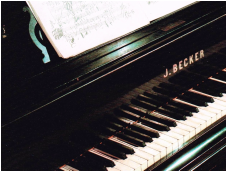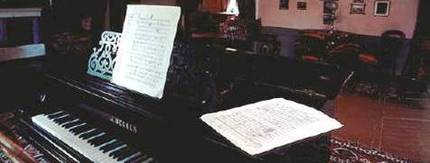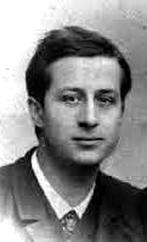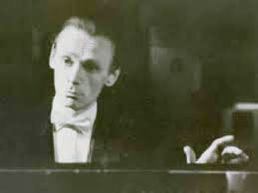 Tchaikovsky's piano at Klin
Tchaikovsky's piano at Klin
Piano Concerto No. 2 in G major, Opus 44
If you are fortunate enough to circulate among people who discuss pianists, there are times you might hear someone say "She/he will perform the Tchaikovsky," or "Yes, I heard him/her play the Tchaikovsky." And what they will mean by "the Tchaikovsky" is the Piano Concerto No. 1, famous and ubiquitous and more than deserving of its fame and popularity.
But there are three concertos, not to mention the delightful Concert Fantasia. The second was Tchaikovsky's favorite however, and a work that he considered to be among his best, in spite of the angst it gave him later. He undertook its composition in 1879, at a time when he found himself at his sister's home in Kamenka with no pressing obligations and consequently feeling rather spiritless. At that time he wrote to his brother Modest complaining that he was experiencing
If you are fortunate enough to circulate among people who discuss pianists, there are times you might hear someone say "She/he will perform the Tchaikovsky," or "Yes, I heard him/her play the Tchaikovsky." And what they will mean by "the Tchaikovsky" is the Piano Concerto No. 1, famous and ubiquitous and more than deserving of its fame and popularity.
But there are three concertos, not to mention the delightful Concert Fantasia. The second was Tchaikovsky's favorite however, and a work that he considered to be among his best, in spite of the angst it gave him later. He undertook its composition in 1879, at a time when he found himself at his sister's home in Kamenka with no pressing obligations and consequently feeling rather spiritless. At that time he wrote to his brother Modest complaining that he was experiencing
a certain vague dissatisfaction with myself, an over-frequent and almost irresistible desire to sleep, a certain emptiness, and finally boredom. There were times when I didn't know what to do with myself. Finally yesterday it became fully apparent to me what was the matter. I had to get on with something: I find myself absolutely incapable of living long without work. Today I began to create something and the boredom vanished as if by magic.
That "something" was his second Piano Concerto. "I am very pleased with it, especially with the second movement, the Andante," Tchaikovsky later wrote to Nadezhda von Meck while in Paris. And although the Andante became a source of some of the trouble mentioned above, it's also one of Tchaikovsky's most achingly lyrical inspirations. More about it later.
Even in his Piano Concerto No. 1, we can see a bold freshness of vision in comparison to concertos that had come before, particularly in Russia, but that originality in invention becomes even more apparent with the second. Of his second concerto, there were complaints about the length and the difficulty when it was first written, and even now as it appears in the original score. It takes about 40-45 minutes to do it justice. (But when is it a sin to take as long to say something as it is essential to say it?) There are three movements: I. Allegro Brillante, II. Andante non troppo, and III. Allegro con fuoco. The first movement is indeed brilliant, lustrous and sparkling and energetic, and it takes approximately 20 minutes in performance. The second movement, the Andante, is around 15 minutes long, and the glittering third movement takes about 7 fiery minutes to perform. Pure Tchaikovsky, for people who like that sort of thing.
 The Piano at Tchaikovsky's home in Klin - Now the Tchaikovsky Museum
The Piano at Tchaikovsky's home in Klin - Now the Tchaikovsky Museum
The work has its critics ─ but many of these detractors view Tchaikovsky askew, through a teutonic/european bias; and who, for whatever reason, seem to be incapable of seeing him as on a pioneering independent musical path, and his work was indeed, for his place and time, quietly revolutionary.
In almost every instance and in almost every genre, Tchaikovsky staked out his own grounds for creating a work and did it on his own terms. His first symphony, Winter Daydreams, wrenched the european model out of what-was-to-be-expected-in-a-symphony into a new Russian symphonic language. Tchaikovsky could easily have written a cello concerto in its "accepted" more academic form, but he hewed to his own vision and created Variations on a Rococo Theme, without doubt a fresh take, scattering expectations, and making it new. And he not only changed the world of ballet music, he transmogrified it. His second piano concerto is in the same mold.
In almost every instance and in almost every genre, Tchaikovsky staked out his own grounds for creating a work and did it on his own terms. His first symphony, Winter Daydreams, wrenched the european model out of what-was-to-be-expected-in-a-symphony into a new Russian symphonic language. Tchaikovsky could easily have written a cello concerto in its "accepted" more academic form, but he hewed to his own vision and created Variations on a Rococo Theme, without doubt a fresh take, scattering expectations, and making it new. And he not only changed the world of ballet music, he transmogrified it. His second piano concerto is in the same mold.
 Aleksandr Ziloti
Aleksandr Ziloti
It is that second movement, the Andante non troppo, the one Tchaikovsky was especially pleased with, that has interfered with the piece taking its rightful place in the concerto repertoire. The arguments over the length and shape of the work took its toll from Tchaikovsky's friends, contemporaries and colleagues. Reluctantly, Tchaikovsky agreed to some cuts here and there, but the unkindest cut of all came from Aleksandr Ziloti (Tchaikovsky's friend, a pianist as well as a conductor), who not only performed the piece with unconscionable cuts and transpositions, it was his butchered version that made its way into the concert hall and, unfortunately, the version that made its way into publication following Tchaikovsky's death. The concerto was not published in the original version as Tchaikovsky intended until 1955. (Ziloti also made cuts and revisions to the Piano Concerto No. 1 as well ─ but more about that another time.)
One of the most egregious cuts was the evisceration of the "trio" section to the Andante at the beginning of the second movement. The original version, which is often called the "trio" movement, is one of Tchaikovsky's most beautiful inventions. Following a short orchestral prelude, a single violin introduces an achingly mournful and melancholy melody, shortly joined by a single cello further unfurling the melody, and only then does the piano join them and the orchestra, and for a time this piano concerto becomes nothing less than a triple concerto. A courageous (and unorthodox) invention on the part of Tchaikovsky, and another mark of his musical genius. The judgment of history is that Tchaikovsky was correct in his original vision ─ and Ziloti has been proven wrong.
One of the most egregious cuts was the evisceration of the "trio" section to the Andante at the beginning of the second movement. The original version, which is often called the "trio" movement, is one of Tchaikovsky's most beautiful inventions. Following a short orchestral prelude, a single violin introduces an achingly mournful and melancholy melody, shortly joined by a single cello further unfurling the melody, and only then does the piano join them and the orchestra, and for a time this piano concerto becomes nothing less than a triple concerto. A courageous (and unorthodox) invention on the part of Tchaikovsky, and another mark of his musical genius. The judgment of history is that Tchaikovsky was correct in his original vision ─ and Ziloti has been proven wrong.
 Igor Zhukov
Igor Zhukov
Concertos have been and continue to be a showcase for a virtuoso. Here, in the Andante, Tchaikovsky defies the common expectation and in service to the music rather than to the soloist, creates one of the most moving sections to ever appear in a piano concerto. The two blazing, passionate, and pyro-technical outermost movements embrace an extraordinarily lyrical, warm, and tender heart. When the work is performed now, fortunately, it is most often heard in Tchaikovsky's original and uncut form, but for too many years it suffered from Ziloti's interference.
(One of the finest interpretations of the original Andante is with Igor Zhukov, pianist; Mikhail Tcherniakhovsky, violin; and Viktor Simon, cello with Gennady Rozhedestvensky conducting the USSR RTV Large Symphony Orchestra*.)
Tchaikovsky's Piano Concerto No. 2 has been overlooked, underperformed, and a sad victim of musical meddling. It is by every measure a monumental work, and is every bit as deserving of attention as his more famous First. If more orchestras and soloists can be persuaded to bring this concerto to the fore, perhaps someday those conversations among music lovers will have to differentiate, favorably, and no one will be able again to say, "We went to hear the Tchaikovsky" without needing to clarify their statement because Tchaikovsky's Piano Concerto No. 2 will have taken its rightful place among the greatest works ever written for Piano and Orchestra.
(One of the finest interpretations of the original Andante is with Igor Zhukov, pianist; Mikhail Tcherniakhovsky, violin; and Viktor Simon, cello with Gennady Rozhedestvensky conducting the USSR RTV Large Symphony Orchestra*.)
Tchaikovsky's Piano Concerto No. 2 has been overlooked, underperformed, and a sad victim of musical meddling. It is by every measure a monumental work, and is every bit as deserving of attention as his more famous First. If more orchestras and soloists can be persuaded to bring this concerto to the fore, perhaps someday those conversations among music lovers will have to differentiate, favorably, and no one will be able again to say, "We went to hear the Tchaikovsky" without needing to clarify their statement because Tchaikovsky's Piano Concerto No. 2 will have taken its rightful place among the greatest works ever written for Piano and Orchestra.
*This movement is from a vinyl recording, to hear the remastered version of the complete piano concerto, click here.
 RSS Feed
RSS Feed